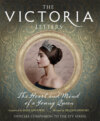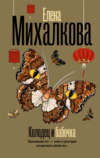Kitabı oku: «The Victoria Letters: The official companion to the ITV Victoria series»



COPYRIGHT
HarperCollinsPublishers
1 London Bridge Street
London SE1 9GF
First published by HarperCollinsPublishers 2016
FIRST EDITION
Text © Helen Rappaport 2016
A Mammoth Screen/Masterpiece Co-production for ITV
Television series, photographs and ‘Victoria’ logo © Mammoth Screen Limited 2016. All rights reserved.
Victoria series photography by Gareth Gatrell
Cover photography © Billy & Hells
All other images © see here
Design © Smith & Gilmore
All quotes in grey text featured at bottom of pages are taken from the fictional Victoria television scripts written by Daisy Goodwin.
All interviews with cast and crew supplied by Alison Maloney, with the exception of those with Daisy Goodwin, which were supplied by Helen Rappaport.
Transcripts of Victoria’s journals, containing all original stress and emphasis, can be found at
www.queenvictoriasjournals.org
While every effort has been made to trace the owners of copyright material reproduced herein and secure permissions, the publishers would like to apologise for any omissions and will be pleased to incorporate missing acknowledgements in any future edition of this book.
With thanks to Patrick Smith
Helen Rappaport asserts the moral right to be identified as the author of this work
A catalogue record of this book is available from the British Library
All rights reserved under International and Pan-American Copyright Conventions. By payment of the required fees, you have been granted the nonexclusive, non-transferable right to access and read the text of this e-book on screen. No part of this text may be reproduced, transmitted, downloaded, decompiled, reverse engineered, or stored in or introduced into any information storage retrieval system, in any form or by any means, whether electronic or mechanical, now known or hereinafter invented, without the express written permission of HarperCollins e-books.
Find out about HarperCollins and the environment at www.harpercollins.co.uk/green
Source ISBN: 9780008196837
Ebook Edition © October 2016 ISBN: 9780008196844
Version: 2016-09-17


CONTENTS

Cover
Title Page
Copyright
Foreword
Introduction
House of Hanover Family Tree, 1714–1837
LITTLE DRINA
FROM KENSINGTON PALACE TO BUCKINGHAM PALACE
THE MAIDEN QUEEN
LORD M
THE GERMAN PAUPER
HER MAJESTY’S HOUSEHOLD
THE COURT OF QUEEN VICTORIA
THE WELFARE OF MY PEOPLE
BECOMING A MOTHER
BEHIND THE SCENES
Cast List
Picture Credits
About the Publisher

FOREWORD
BY DAISY GOODWIN
WHO WAS QUEEN VICTORIA? The image most of us have is of an old lady in a bonnet dressed in black, the woman who is immortalised in countless statues all over the country. Until this year, she was our longest reigning monarch, coming to the throne in 1837 when she was eighteen and reigning for sixty-three years until her death in 1901. Photography was invented in the early years of her reign, but the first images of Victoria and her husband Albert were taken in the 1850s, when Victoria was already a mother of nine, so we have no photographic record of the young Victoria, the teenager who on the morning of 20 June 1837 woke up to find that she was the queen of the most powerful country in the world. But we do have records of her diaries, which have left behind an indelibly vivid picture of the passionate strong-willed girl. Here she is writing about Albert shortly after their engagement, ‘I just saw my dearest Albert in his white cashmere breeches, with nothing on underneath!’, or after their first parting, ‘Oh how I love him, how intensely, how devotedly, how ardently! I cried and felt so sad. Wrote my journal. Walked. Cried.’
I first came across Victoria’s journals when I was at university studying nineteenth-century England, and I was immediately taken by the girl that sprang out of the pages. Many years later when I had a teenage daughter of my own, I had a row with her one morning and it suddenly struck me that she was pretty much the same age and size (five foot nothing) as Victoria when she became Queen, and then I thought, what would happen if she woke up one morning and found that she was the most famous woman in the world? From that moment on I started writing scenes in my head, and the idea for Victoria the TV series was born.
From the beginning I wanted to show Victoria as a girl who had to do her growing up in public. Most of us get to make our adolescent mistakes in private but Victoria had to do everything under the scrutiny of her courtiers, the press and the public. There were no royal spin doctors in those days, and when Victoria made mistakes, and she made some serious ones in the early years of her reign, there was no press office to hide behind. There were plenty of people who thought that an 18-year-old girl could not be an effective monarch.
But it is clear when you read Victoria’s own words that she was a woman with an extraordinary sense of her own identity. Despite having every aspect of her early life controlled by her mother and her mother’s advisor Sir John Conroy, Victoria was not moulded by them. From the moment she came to the throne she was determined to do things her way. To take one example, as a baby she had been christened Alexandrina Victoria after her godfather, Alexander of Russia, and her mother Victorine; as a little girl she was called Drina by her mother and her governess Lehzen. But on her accession she decided that instead of taking a ‘queenly’ name like Mary or Elizabeth, she wanted to be called Queen Victoria – this was shocking at the time because the name Victoria was completely new, but Victoria, my heroine, knew instinctively that it was the right name for her. In that sense at least, she created the Victorian age.
I have used the girl that springs out of Victoria’s diaries and letters as the basis for the character that Jenna Coleman plays with such skill in the series. I hope that watching the show will make people curious about Victoria, and this book, so brilliantly put together by the nineteenth-century expert Helen Rappaport, is the perfect place to start if you want to know the history behind the series.
I hope that the series and this book will show that Victoria is very much a heroine for our times. In many ways she is the first woman to have it all – her struggles to be a wife and mother as well as a queen resonate across the centuries. She wasn’t perfect but she was brave and resolute and a great deal more than an old lady in a bonnet.
~DAISY GOODWIN, SCREENWRITER OF VICTORIA


INTRODUCTION
THE HEART AND MIND OF A YOUNG QUEEN
‘All trades must be learned, and nowadays the trade of a constitutional Sovereign, to do it well, is a very difficult one.’
– King Leopold to Queen Victoria –
– 16 January 1838 –
FEW MONARCHS IN BRITISH HISTORY have been so extensively written about as Queen Victoria. Like Henry VIII and Elizabeth I, it seems that nothing can dim our enduring fascination with her or our hunger for new film and TV dramatisations of her life. Much like her two charismatic Tudor predecessors, Queen Victoria has been the subject of endless interpretation and re-evaluation, and one might think there is nothing new left to say, no new revelations to be made.
Until now, most dramatisations have concentrated on the older, more mature queen, and in particular on her life after Albert, as a widow. But in this new eight-part series for ITV, screenwriter Daisy Goodwin has put the Queen’s very first faltering steps as monarch under the microscope.


‘This book, Mamma gave me’
– Victoria –
ON 31 JULY 1832, the first page of the story of Victoria’s long life was written, when as a 13-year-old princess and already Heir Presumptive to the throne of the United Kingdom of Great Britain and Ireland, she inscribed the flyleaf of the shiny new red leather journal presented to her by her mother:
This book, Mamma gave me, that I might write the journal of my journey to Wales.
~ VICTORIA’S JOURNAL, 31 JULY 1832
Over the next 70 years, what began as an educational exercise in recording the relatively mundane events of her young life, to be submitted for daily inspection to her governess and her mother, would grow into 141 handwritten volumes – probably the greatest and most enduring personal record written by any queen at any time in history.
Beginning with her first childish observations of people, places and events, young Princess Victoria recorded a detailed description of her daily life at Kensington Palace, her love for her dolls and her dog Dash; and spoke poignantly of her isolation from the outside world. On her accession in 1837, and moving to Buckingham Palace, she filled the pages of her journals with fascinating accounts of the people who made the greatest impression on her (notably her first prime minister, Lord Melbourne), her hopes and aspirations about the onerous responsibility of becoming Queen that had been thrust upon her very young shoulders, and the joy of finding love and a happy marriage, so rare in the dynastic scheme of things.
In tandem with her diary, Queen Victoria’s enormous output of letters dating from 1832 chart a queen in the making and show her wrestling with some of the challenging political issues of her day and making her first difficult decisions as monarch.
This book, in tandem with the television series, tells the touching and intimate developing story of the young princess who became Queen in 1837, based closely on her journals and letters and featuring many key quotations from them. The Victoria Letters reveals at first hand a view of the queen who became our second-longest-reigning monarch after Queen Elizabeth II, with all her quirks and foibles, her impetuosity and her compassion.
~ HELEN RAPPAPORT, JUNE 2016



LITTLE DRINA
‘It was a rather melancholy childhood’
– Victoria –
ON 28 APRIL 1819 A RAGGLE-TAGGLE CONVOY of 20 carriages, thick with the dust and grime of 30 days on bumpy roads from Amorbach in Bavaria, rattled up the drive of London’s Kensington Palace. The journey its exhausted occupants had just completed – along with a mountain of luggage, two Russian lapdogs and a cage of singing birds – had been a frenetic race against time to ensure that the first legitimate heir to the British throne to be produced by any of George III’s sons be born in England.
The soon-to-be parents were Edward, Duke of Kent – the fourth of the nine sons of George III – and his wife, Marie Louise Victoire, formerly a princess of the German duchy of Saxe-Coburg-Saalfeld. They had until now been living at Amorbach in greatly straitened circumstances – thanks to an accumulation of debts brought on by the Duke’s compulsive overspending from the moment he completed his military training.
Their one hope of a change in fortunes had followed the death of Princess Charlotte of Wales (the Duke’s niece and Duchess’s sister-in-law), who had died tragically in 1817. If the Duke outlived his elder, childless brothers, he would become King. And the child his wife was soon to bear, the one most likely to outlive them all, would be fifth in line to the British throne.

BY 1819, THE DUKE OF KENT WAS 50. Determined to marry and beget an heir, the previous year he’d discarded his long-term French mistress, Madame St Laurent – giving her a pension for going without making a fuss – and set about finding a wife. As a son of King George III, he knew that his marriage to Victoire of Saxe-Coburg was far from ideal. She was considerably inferior in royal dynastic terms and was a widow with two children. But the Duke needed to legitimise his claim to the throne in the eyes of the public by marrying and becoming a respectable family man.

Announcement of the Royal birth in The London Gazette.
Despite the draining 427-mile journey from the Continent, at 4.15 a.m. on 24 May, the Duchess of Kent, who seemed to have suffered no adverse effects, gave birth to a pretty, fair and fat baby girl. She was very like her father, having the unmistakably large blue eyes of the Hanoverians. The birth prompted the entire British nation to heave a sigh of relief, for it came during one of the old King George III’s bouts of madness and the Regency of his eldest, unpopular son George.

‘Fair and fat’ – baby Victoria.
Script quote:

Duchess of Kent:
Driving in a coach from Amorbach, across France, so that you could be born in England – I was so worried that you would come early and your wicked uncles would say you were not English.

THE DUCHESS OF KENT HAD RESISTED the services of a male physician to deliver her child and had instead brought with her the family’s own German obstetrician, Marianne Siebold – one of the first women in Europe to obtain a medical degree. Siebold announced the birth to the dignitaries who had gathered in an ante-room to bear witness to the legitimacy of the birth, among them the Duke of Wellington. ‘Boy or girl?’ he asked her.
‘Girl,’ answered the doctor, then added in her thick German accent, ‘Ver nice beebee. No big, but full. You know, leetle bone, moosh fat.’
Just three months later, Marianne Siebold would deliver another baby, at the Castle Rosenau near Coburg – the son of the Duchess of Kent’s brother, Duke Ernest of Saxe-Coburg, and a cousin to the little Princess. From the outset, the grandmother of the two infants, the dowager Duchess of Saxe-Coburg-Saalfeld, was determined that her dear grandson Albert and her adored new granddaughter should one day marry. From her home in Ebersdorf she wrote adoringly of little baby Albert. ‘What a charming pendant he would be to the pretty cousin,’ she remarked, setting the matchmaking wheels in motion.

Young Prince Albert, Victoria’s cousin and young suitor.
Feature:

PRINCESS CHARLOTTE

‘She might have been saved if she had not been so much weakened’
– Victoria –
CHARLOTTE (BORN 1796), only child of George, Prince Regent by his wife Caroline of Brunswick, was until her death George III’s only legitimate grandchild. Warm-hearted and engagingly impulsive, she was under pressure to secure an advantageous dynastic union through marriage to Prince William of Orange. She was desperate to find an alternative, and after meeting Leopold of Saxe-Coburg-Saalfeld, pleaded with her father to be allowed to marry him instead. Alexander I of Russia saved the situation by offering his sister Anna to the Prince of Orange, and the Prince Regent allowed Charlotte and Leopold to be married in 1816. It seemed a happy union and was popular with the British public, who were overjoyed at the news of their much-loved princess’s pregnancy in 1817.
Charlotte, though robust and healthy, was put on a strict diet and bled mercilessly during pregnancy. After an agonising, protracted two days of labour, made worse by incompetent doctors, on 5 November 1817 she gave birth to a stillborn son but shortly afterwards suffered a haemorrhage, and died of shock and exhaustion. Her death provoked unprecedented public grief: regarded as a national disaster, the simultaneous deaths of two heirs to the British throne presented a potential crisis in the monarchy. There was now a race to see who, among George III’s surviving sons, could produce a legitimate heir to replace Charlotte. Adelaide, wife of the Duke of Clarence (the future William IV), hoped to give birth to an heir, but between 1819 and 1822 lost all four of her babies.
Having lost his wife and child, Leopold made it his life’s mission to prepare Victoria for the throne that Charlotte should have occupied.

VICTORIA’S DELIGHTED FATHER PRONOUNCED his new baby daughter ‘as plump as a partridge’ and was ridiculously proud and protective of her.
‘Don’t drop her! Don’t drop her! You might spoil a queen!’ he had told the Bishop of Salisbury when he visited soon after and took the baby awkwardly in his arms. Mindful of his daughter’s royal prospects, the Duke announced that he wished her to be named Elizabeth after the great Tudor monarch, but at her christening the Prince Regent instead chose the name Alexandrina, after the baby’s godparent Tsar Alexander I of Russia, who had recently been Britain’s ally in the war against Napoleon. Then, after some prevarication, and with everyone gathered expectantly around the font, he allowed a second name, Victoire, after her mother. Fondly nicknamed Mai-blühme, or May Blossom, by her German mother and grandmother throughout her early childhood, the princess who would become Queen in 1837 was generally known as Drina.
The first happy months of Drina’s life were, however, brought to a sudden end when, in January 1820 while staying by the sea at Sidmouth in Devon, her father caught a chill and died of pneumonia. His last words were to beg God to protect his wife and child.
Although she would never have more than the most distant recall of her father, Victoria later remarked, ‘I was always taught to consider myself a soldier’s child.’ She nursed a somewhat rosy view of her father’s long and not altogether distinguished military career, which was to give her a lifelong admiration for the army. But she missed his presence and throughout her life, as if to compensate, she would latch on to a succession of strong father figures.
Six days after the Duke’s death, his father King George III also died. In less than a week little baby Drina was propelled a great deal closer to the throne.

The Duke of Kent, Victoria’s father and fourth son of George III.

Kensington Palace, Victoria’s childhood home.
Feature:

KENSINGTON PALACE
‘My dear old home’
– Victoria –
THE ORIGINAL KENSINGTON PALACE, built on the western edge of Hyde Park in 1661, was a red-brick Jacobean mansion situated in what was then a beautiful, tranquil park of chestnut and beech trees. It was bought by the royal family in 1689 for King William III, because the damp riverside palace at Whitehall had aggravated his asthma. During William’s reign the interior of the house underwent extensive renovations designed by the architect Sir Christopher Wren. Queen Anne loved it so much that in 1704 she added a grand orangery, and George I ordered its beautiful gardens to be laid out in 1723–27 by the landscape gardener William Kent.
Little money, however, was spent on maintaining the exterior fabric of the building and it fell into disuse as a royal residence after the death there of George II in 1760. Once Buckingham House (later Palace) was built in central London, George III preferred to live there and Kensington instead became a home for minor royals. The Duke of Kent had been allocated two floors of apartments in 1798, which he furnished, at considerable expense, with new upholstery, curtains and bed hangings. The new furnishings, however, did little to enhance the dark and gloomy interior, which had long been infested with black beetles and other insects, and the Duke’s mounting debts drove him to seek refuge abroad.
By the time Victoria was born, Kensington Palace’s only remaining occupant was her rather frightening and eccentric Uncle Sussex. She later recalled:

My earliest recollections are connected with Kensington Palace, where I can remember crawling on a yellow carpet spread out for that purpose – and being told that if I cried and was naughty my Uncle Sussex would hear me and punish me, for which reason I always screamed when I saw him!
VICTORIA’S REMINISCENCES OF HER EARLY CHILDHOOD, WRITTEN IN 1872

Uncle William and Aunt Adelaide send their love to dear little Victoria with their best wishes on her birthday, and hope that she will now become a very good Girl, being now three years old. Uncle William and Aunt Adelaide also beg little Victoria to give dear Mamma and to dear Sissi a kiss in their name, and to Aunt Augusta, Aunt Mary and Aunt Sophia too, and also to the big Doll. Uncle William and Aunt Adelaide are very sorry to be absent on that day and not to see their dear, dear little Victoria, as they are sure she will be very good and obedient to dear Mamma on that day, and on many, many others. They also hope that dear little Victoria will not forget them and know them again when Uncle and Aunt return.
LETTER FROM THE DUCHESS OF CLARENCE TO VICTORIA, 24 MAY 1822
My dearest Uncle – I wish you many happy returns on your birthday; I very often think of you, and I hope to see you soon again, for I am very fond of you. I see my Aunt Sophia often, who looks very well, and is very well. I use every day your pretty soup-basin. Is it very warm in Italy? It is so mild here, that I go out every day. Mama is tolerable well and am quite well. Your affectionate Niece, Victoria.
P.S. I am very angry with you, Uncle, for you have never written to me once since you went, and that is a long while.
LETTER FROM VICTORIA TO LEOPOLD, 25 NOVEMBER 1828
FOR THE MOST PART, life at Kensington Palace was unremittingly quiet and uneventful for the young Victoria:
We lived in a very simple, plain manner; breakfast was at half-past eight, luncheon at half-past one, dinner at seven – to which I came generally (when it was no regular large dinner party) – eating my bread and milk out of a small silver basin. Tea was only allowed as a great treat in later years.
Ücretsiz ön izlemeyi tamamladınız.











